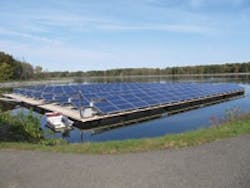About the author: Suzanne Chiavari is vice president of engineering for New Jersey American Water. Chiavari can be reached at 856.782.2304.
Aiming to lower energy costs and decrease its carbon footprint, New Jersey American Water, a wholly-owned subsidiary of American Water, is investing in solar technology. Most recently, the company installed solar modules on a reservoir at the Canoe Brook Water Treatment Plant (WTP) in Millburn, N.J. This is the first solar array on the East Coast on a body of water designed to withstand a freeze-thaw environment.
American Water treats, pumps and delivers 1 billion gal of water per day. This takes a substantial amount of energy. The company’s goal is to lower its greenhouse gas emissions per volume of water produced by 16% by the year 2017. A large portion of this reduction will come from increasing pump efficiencies, but 6% is slated to come from increasing use of renewable energy sources in New Jersey.
The Power of the Sun
Solar energy generates electricity without pro- ducing harmful greenhouse gases and produces maximum output at times of peak demand, when electricity is of highest value. Solar energy can be purchased from a third-party supplier or owned outright. After analyzing the rebate incentives, energy cost savings and other factors, New Jersey American Water chose to invest in owning the system.
System Design
Canoe Brook WTP lacked the space needed for traditional ground-mounted solar arrays. The plant sits on more than 500 acres of protected land, and only a small portion of the property can be used for construction and operational purposes. With so little space available, a 735-million-gal reservoir nearby was the most viable place to install solar panels.
The 400 solar modules measure 110 ft by 110 ft and rest on a docking station designed to float on the water’s surface. The array will generate 112 kW of direct-current power, which then will be converted to alternating-current power. Annually, the solar field will produce 135,000 kWh per year, or approximately 2% of the plant’s power.
The solar panels are fixed at a 14-degree angle and made specially to endure severe weather conditions (e.g., heavy wind, rain, snow and ice), allowing this pilot project to be monitored for the effectiveness of the solar station during inclement weather changes.
Because the reservoir has a 6- to 9-in.-thick clay liner, the array needed to be secured without penetrating the reservoir lining. The project team designed a unique mooring system that allows it to rise and fall with the water level of the reservoir. A system of elastic bands connects the docking The solar modules measure 110 ft by 110 ft and rest on a docking station designed to float on the 735-milion-gal reservoir’s surface. system to anchors at the bottom of the reservoir, preventing twisting or turning but allowing it to move up and down in response to changes in water level, or laterally as a result of ice. On the underside of the docking system, special connec- tion details are used to attach the elastic bands. The anchors consist of 25 concrete blocks, each weighing 4 tons.
Construction Details
The project was constructed for about $1.3 million. While tax credits and other inducements are expected to help defray some of the costs, New Jersey American Water has applied for a tax rebate of up to 30% of the total project cost as a result of the federal American Recovery and Reinvestment Act (ARRA) of 2009. Also known as the stimulus package, the ARRA has a progressive clean energy program that provides incentives for alternative power projects. Meanwhile, the state of New Jersey also offers economic incentives for renewable energy projects, which are key for solar projects.
Environmental & Social Benefits
Renewable energy technologies are clean sources of energy that have a significantly lower environmental impact than conventional energy technologies. By producing 135,000 kWh per year, this equivalent energy does not have to be pro- duced by other traditional electric generation, such as equipment fired by coal, natural gas or oil.
Over the next year, New Jersey American Water will be evaluating the performance of the array and the extent of maintenance required. Once the system operates for a year, the company will decide whether to expand the array and, if so, by how much. The system is expected to be essentially mainte- nance free, with monthly inspections planned.
By exploring new ways to use green energy to help power the Canoe Brook WTP and other facilities, the company will generate approximately 3.5 million kWh per year by the power of the sun, which benefits the customers and the company.
Water companies throughout the U.S. would be wise to investigate local incentives for renewable energy and to implement energy-efficiency programs to reduce environmental impacts, energy costs and their future exposure to higher electricity costs. WWD
Download: Here
